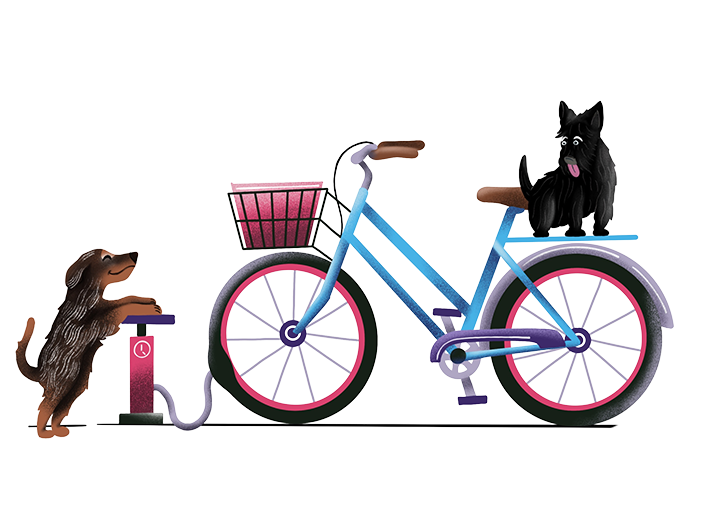Menu

On its surface, content marketing sounds simple – brands create relevant content, publish it on different channels, and reap the benefits for their business. But like traditional marketing, there are many complexities and nuances that businesses get to know as they try to understand the basic principles, tactics, and techniques used in content marketing.
There are lots of terms to learn when a brand implements different content marketing strategies to help the business grow – from common words like audiences to more complicated jargon like SEO, SERP, and KPI. To help you clear the confusion and uncomplicate these matters, we’ve compiled a list of common content marketing terms to familiarize yourself with.
Content marketing is more than just creating and distributing valuable content – there are lots of different factors that affect the success of each campaign so it’s important to understand what you’re doing and why you’re doing it.
According to a study by Semrush, content marketing is one of the most commonly used marketing techniques today with about 97% of businesses implementing the strategy in their promotional efforts. But what exactly is content marketing?
Different sources online have different definitions of content marketing but they all have the same core message – content marketing involves the creation and publication of relevant content to subtly drive traffic and increase sales of a business. This meaning sounds straightforward, but there are a lot of considerations when working with content marketing strategies.
Anyone new to content marketing can easily get confused with all the jargon, so the first step is to familiarize themselves with the most basic and commonly used content marketing terms. From there, they can start building effective strategies and reaping the benefits of content marketing.
While it’s true that there are certain words that you learn as you go, it’s crucial to remember that even seasoned veterans in content marketing may still interpret some terms differently. Without proper definitions, marketers may experience challenges when it comes to communicating with teams and executing strategies.
Like in other industries, the definition of specific terms is important because it ensures that most individuals have a common understanding of the term they use. When they use certain terms like digital content or lead generation, content marketers know that they’re all on the same page about the topic – making the discussion go a lot smoother and easier.
Although some people use them interchangeably, digital marketing is different from content marketing. To be more specific, content marketing is a type of digital marketing, along with affiliate marketing, search engine optimization, and social media marketing among others. Digital marketing is a lot more direct in converting the target audience into new customers while content marketing utilizes subtle and indirect approaches.
Other alternate terms that some people use for content marketing include brand journalism, brand publishing, and native advertising, but all of these terms have their own meaning and appropriate usage. According to content marketers, the only correct term for content marketing is content marketing itself.
To make everything a bit easier for newbies, we made a list of common terms you might encounter in content marketing. We organized each jargon to fit a certain category, but remember that some of them may encompass multiple areas of content marketing.
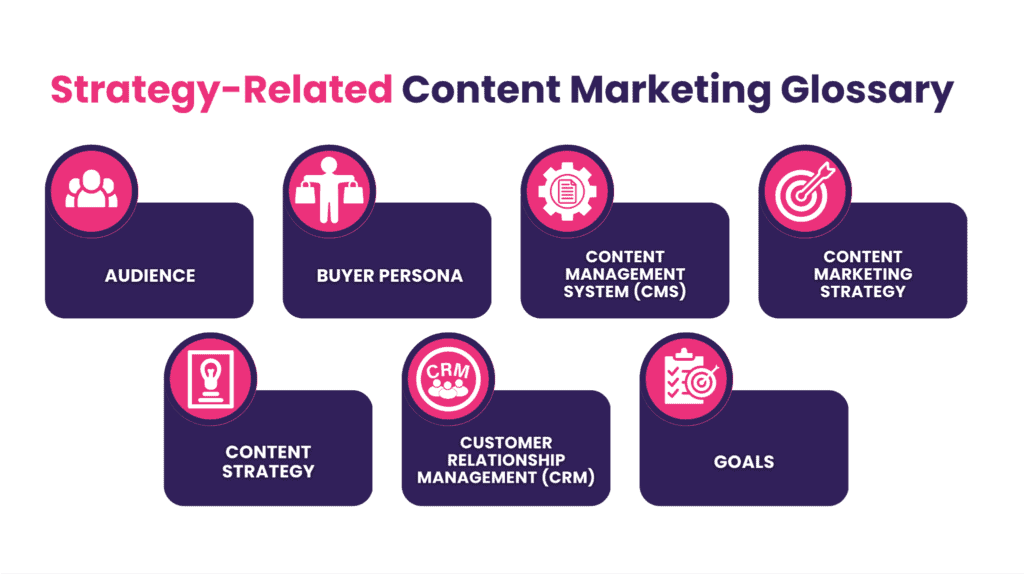
The target audience, or simply audience, is the group of site visitors interested in the brand and what it offers. They’re a clearly defined group of individuals that brands have to consider whenever they create content. These people willingly read, view, listen, or engage with the brand’s content in exchange for benefits, like gaining the relevant information they need.
The buyer persona is the representation of the prospective buyers in a clearly defined audience. Establishing a persona allows brands to predict how users interact with the brand. This allows them to tailor their content and deliver the best experience to their audiences.
A content management system (or CMS) is a type of software that helps businesses create, modify, and manage their content on a web page even without the need for expert technical knowledge. It’s a useful tool that helps new businesses build a website without having to write all the codes. A popular example of CMS is WordPress.
Content marketing strategy is the brand’s plan or blueprint for building an audience and promoting its business. It’s often described as the “why” a brand uses content marketing – why they create content, who they serve, and how it’s unique from the rest.
Content strategies are often confused with content marketing strategies, but they’re different. A content strategy is a plan for creating, distributing, and managing all of the content produced by a brand – including those used in content marketing strategies.
This is a type of technology that businesses use to manage their interactions and relationships with potential, new, and existing customers. The goal of each CRM is to improve business relationships through different strategies, principles, or practices.
Goals in content marketing are the objectives that the brand wants to achieve through its techniques and strategies. Although the ultimate goal for all businesses is to drive profitable actions from readers, each program goal should be more specific and attainable.
Some of the most common goals for content marketing campaigns include: growing sales, saving costs, improving brand satisfaction, or boosting customer loyalty. Goals should be measurable within an achievement date.
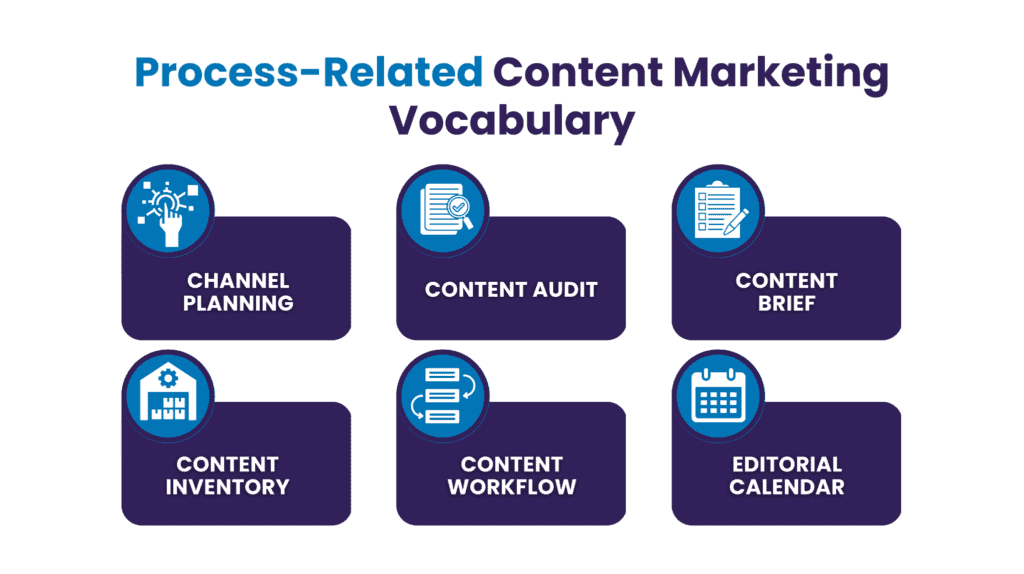
Media or channel planning is an important part of any strategic marketing approach. It’s the process of choosing where, when, and how often the brand message should be delivered to the audience.
The idea behind channel planning is to reach the most number of the right audience members using the right brand message as often as necessary. Having a channel plan prepares the brand for managing content in the ever-changing list of distribution channels and social media platforms.
A content audit is a process of evaluating all the content assets in the brand’s inventory. Conducting a content audit now and then is important for businesses because it allows them to assess the quality of each piece of content, how it addresses customer needs, and whether it performs well to satisfy the business objectives.
A content brief is a well-constructed set of instructions often given to freelancers, consultants, and other outsourced content teams involved in online content creation. Having a documented content brief ensures that the content writer produces the content based on the brand’s marketing expectations and editorial standards.
When creating a content brief, it should include important details like the description of the task, key messages, target audience insights, and relevant branding details (like the tone, voice, and style).
The content inventory is the collection of data about all of the site’s content. It should be a comprehensive, qualitative list written in a spreadsheet that details all of the content assets. It should also include other information like content type, channels, distribution formats, and other important details about the online content.
Having a content inventory is important when conducting a content audit. It enables marketers to make important decisions regarding their content production and marketing strategy.
A content workflow is the set of steps and tasks that content teams must follow and complete before distributing valuable content. Some content workflows made by other businesses define the roles and responsibilities of each team member.
Each brand follows a different content workflow, but the most basic examples should include critical tasks of the editorial process. This includes submitting an outline, writing the content, reviewing the finished article, editing all errors, approving the final draft, and then publishing the finished content.
An editorial or content calendar is a tool that helps brands track all the parts of their content plan. It’s especially useful for managing content marketing campaigns because it allows brands to avoid missing deadlines and track the performance of each content. A good editorial calendar should include details like the topic, author information, title, schedules for publication, and other promotional details.

Copy editing is one of the most important editorial techniques used in content marketing to ensure the quality, accuracy, and clarity of the content on a given web page. It involves reviewing and editing the content or copy for any grammatical errors or stylistic inconsistencies that affect its quality. Copy editors may also rewrite the content when necessary to fix problems with wordiness, transitions, style, and jargon use.
Curation is the collective process of assembling, selecting, categorizing, commenting, and presenting a relevant piece of content. It usually requires third-party content in which the brand incorporates its own spin. Other companies that partnered with the brand for this process may also curate its published content.
Fact-checking is another editorial technique used by content marketers to optimize the article. It’s conducted to verify the accuracy of all the information mentioned in the content. Fact-checking is crucial for brands so that they don’t accidentally spread disinformation, miscredit sources, get flagged for plagiarism, and commit other mistakes that might make them lose the trust of audiences.
These 3 content types are commonly found in the blogs of many businesses. Evergreen content refers to articles and pieces that stay relevant and up-to-date for a long time. Every business needs an evergreen blog post on its web page because it continually drives traffic to the website.
On the other hand, long-form and short-form content are some of the many content types that brands use to promote their products or services. The main difference between them is the length of the article (for written content) or the average time it takes for the audience to consume it (for visual and audio content).
Landing pages are specialized web pages made specifically to market or advertise a campaign, service, or product offered by the brand. It’s the particular page where site visitors “land” after they click a specific link in an ad, email, or other similar web spaces. What makes a landing page different from other types of content is that it only focuses on a single goal – encouraging the reader to make a profitable action before they leave.
Proofreading is often lumped with editing, but it’s really a separate process of its own. During this stage of content creation, a proofreader scrutinizes the content just as it’s about to be published on a particular page. This is to catch any typographical error or mirror mishap that the editor or writer missed during the early stages of production.
This refers to original, brand-specific content made by customers and published on the brand’s site or posted on various social media sites. User-generated content takes many forms, including reviews, testimonials, podcasts, videos, images, and more.
Visual and multimedia content are the other types of content that marketers use to promote a brand. They can be separate content of their own (known as video marketing), but they can also be included in long-form written content to make it more enticing and improve its readability.
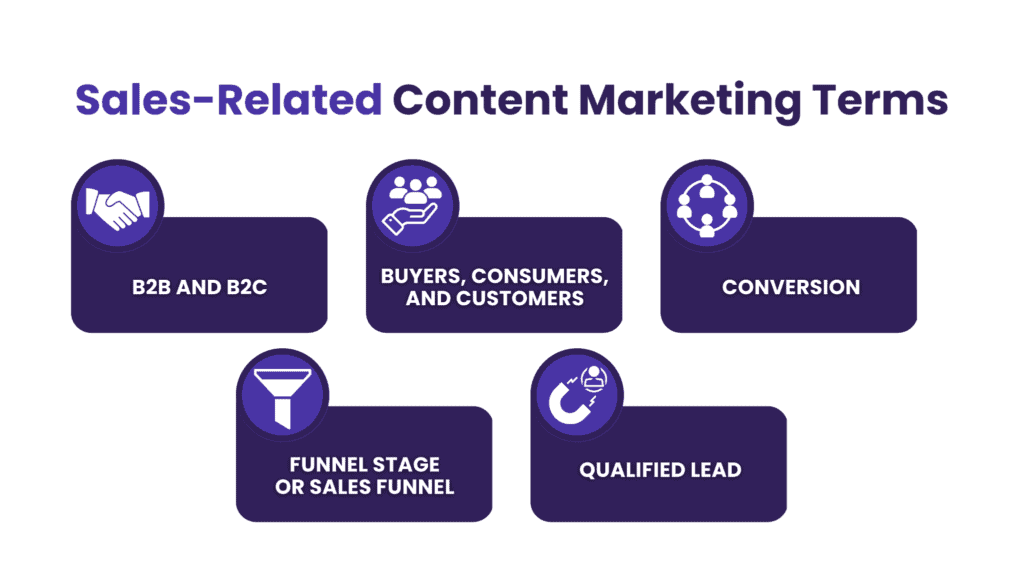
These are the 2 types of companies that brands might often encounter in content marketing. B2B means “business to business” while B2C means “business to consumer.” They offer products and services to different audiences, which means they also require different sales and marketing approaches.
These 3 terms are usually interchangeable, but they have slight differences that set them apart from the others. Buyers are still considered prospects, but they have already shown active interest in purchasing the brand’s product or service.
Consumers are often used interchangeably with buyers, but according to marketers, they are the group of people who are the intended customers for the business. But unlike buyers and consumers that have only expressed interest in engaging with the brand, customers have already actively purchased a product or service from the brand.
Conversion takes place when a consumer takes an action that’s beneficial to a business after interacting with the relevant content. It can be joining a social media community, subscribing to a blog or newsletter, registering for gated content, or purchasing a product.
This marketing process maps the decision-making process of customers – from the time they’re exposed to the content up to their decision whether or not to buy a product or service. There are several steps to the sales funnel, including the top of the funnel (TOFU), middle of the funnel (MOFU), and bottom of the funnel (BOFU). Content marketers need to understand each funnel stage because they must create content specifically for each stage of the buyer’s journey.
Leads are people or businesses within the company’s database that have already engaged with the brand at least once – whether it’s signing up for gated content or purchasing a product. Lead generation is great, but what most brands need are more qualified leads – the prospects evaluated by the sales team to have a high chance of buying something from the brand.
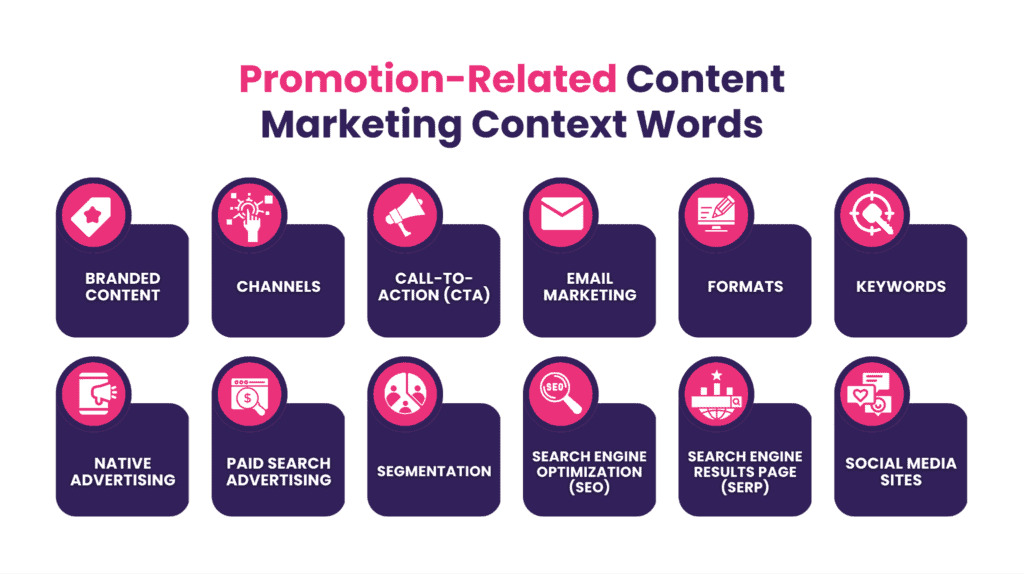
When brands pay for and publish content that features their name or logo, then it’s already called branded content. This kind of content is designed to boost brand awareness by associating the brand itself with the content and the value it offers audiences.
Channels refer to the different distribution channels that brands use to publish and promote their company, products, or services. It can be blogging sites, podcast channels, or social media platforms like Facebook, Twitter, Instagram, Youtube, and others.
Calls to action are statements that encourage audiences to take action after engaging with the brand’s marketing campaign. CTA sections don’t always have to urge audiences to purchase a product or service – they can also tell readers to subscribe to the newsletter, sign up for a webinar, explore other web pages on the site, and other actions that align with the business’s long-term goals. The best CTAs are clear, simple, noticeable, and inviting.
Email marketing is a powerful online marketing channel that utilizes emails to promote a business’s products and services. Brands can also use it to incentivize subscribers and loyal customers by offering them discounts, gated content, and other perks through email. Many brands also integrate this strategy into their marketing automation efforts to help with lead generation, brand awareness, and customer relationships.
Content formats are the way content is presented to audiences for distribution and engagement. The best type of content format to use varies per the target audience and content topic, but here are the main types used by businesses for their marketing technique: visuals for videos and infographics, audio for podcasts, and text for blog posts and ebooks.
A keyword is a word or short phrase about a specific topic that users type on search bars to find a particular web page. Keywords are used to identify and evaluate the value of each piece of content relative to the search intent. To make the brand visible and increase its content value, the strategic placement of keywords in the document should be carefully considered.
Native advertising is a type of paid advertising which matches the tone and style of the publication where it appears. However, the content itself is paid for by the brand to promote its product or service. Native advertising can come in different forms like videos, editorials, or articles.
This type of digital marketing strategy involves paying search engines to place a particular web page or ad high on the relevant search engine results page (SERP). The goal of this search engine marketing is to drive traffic to the brand’s website. The most common example of paid search advertising is pay-per-click (PPC).
Segmentation is one of the important keys to marketing success because it helps brands understand their audiences better. This process involves categorizing members of the target audience into smaller groups based on well-defined criteria. Each segment or group has a common characteristic that brands focus on, allowing them to personalize their marketing technique.
Search engine optimization (SEO) is a set of various strategic tactics and techniques utilized by businesses to enhance the visibility of their website in organic search results. They use building blocks like backlinks, keywords, and others to get the content to rank high on Google search pages and other search engines.
With a higher SEO ranking, the content is more visible to audiences. This results in an increase in website traffic, which can potentially turn into leads and sales.
Search engine results pages (SERPs) are the particular web pages that search engines show after a user submits a query on the search bar. In a SERP, users may find organic search results, featured snippets, paid search advertising, and pay-per-click ads.
Social media sites are applications and websites that allow users to communicate, interact, collaborate, and share content. Each social media post you find on platforms like Facebook, Twitter, Instagram, and others can be seen by everyone else. This makes social media sites a good avenue for brands to interact with their audiences, create communities, and listen to their consumers.
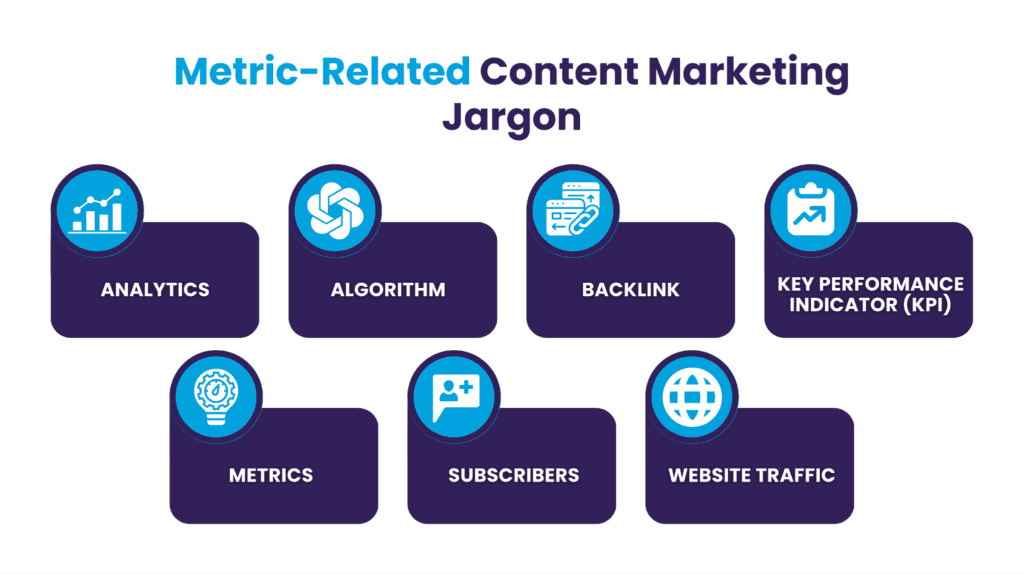
Analytics is the practice of studying and managing different metrics data to determine the success of different marketing efforts. Data mining analysis through this practice allows brands to identify improvement opportunities.
Algorithms are the complex model or criteria that search engines follow when retrieving, analyzing, and ranking content based on their quality and relevance to the user’s query. Brands should be aware that these algorithms are constantly changing, so it’s crucial to always follow them to rank high in SERPs.
A backlink (also known as an inbound link) shows other web pages that are linked to the brand’s posts. Search engines love backlinks, so brands can expect their rankings and site traffic to rank high if they have appropriate backlinks from credible sources.
Key performance indicators (KPIs) are the standard measurements that help brands assess their progress and compare it to their content marketing goals. Some of the most commonly used KPIs are average conversion rate, click-through rate, lead quality, number of leads, revenue per new customer, and more.
Metrics are similar to KPIs in that they’re also measurements, but they don’t exactly focus on the critical business goals. They’re more of “baseline” numbers that businesses must reach to optimize their KPIs.
Subscribers are the part of audience members who have taken certain actions after engaging with the brand’s content. In exchange for their personal data, subscribers expect to receive ongoing value from the brand – like offers for new products, discounts, freebies, gated content, and more. The number of subscribers is also considered the core metric for measuring content marketing value.
Website traffic simply refers to how many visitors clicked on a particular web page. This is usually measured in visits or sessions to find out if the business is successful in attracting an audience.
Although this glossary of content marketing terms isn’t a complete list, it should be enough to clarify common misunderstandings and confusion in industry concepts and terms. Trial and error are needed in content marketing because you only learn new things as you make mistakes and dive deeper into the industry.
If you’re still feeling overwhelmed with the number of terms to know while adapting a good content marketing strategy, it always helps to consult a content team to teach you the ropes.
